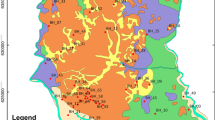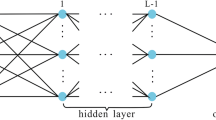Abstract
In this research, deep learning (DL) model is proposed to classify the soil reliability for liquefaction. The applicability of the DL model is tested in comparison with emotional backpropagation neural network (EmBP). The database encompassing cone penetration test of Chi–Chi earthquake. This study uses cone resistance (qc) and peck ground acceleration as inputs for prediction of liquefaction susceptibility of soil. The performance of developed models has been assessed by using various parameters (receiver operating characteristic, sensitivity, specificity, Phi correlation coefficient, Precision–Recall F measure). The performance of DL is excellent. Consistent results obtained from the proposed deep learning model, compared to the EmBP, indicate the robustness of the methodology used in this study. In addition, both the developed model was also tested on global earthquake data. During validation on global data, both the models shows good results based on fitness parameters. The developed classification models a simple, but also efficient decision-making tool in engineering design to quantitatively assess the liquefaction potential. The finding of this paper can be further used to capture the relationship between soil and earthquake parameters.






Similar content being viewed by others
References
Amodei D et al (2006) Deep speech 2: end-to-end speech recognition in english and mandarin. In: International conference on machine learning, 2016, pp 173–182
Boulanger RW, Idriss I (2015) CPT-based liquefaction triggering procedure. J Geotech Geoenviron Eng 142:04015065
Çetin KÖ (2000) Reliability-based assessment of seismic soil liquefaction initiation hazard, vol 2. University of California, Berkeley
Chollet F (2017) Deep learning with python. Manning Publications Co., New York
Das SK, Muduli PK (2011) Evaluation of liquefaction potential of soil using genetic programming. In: Proceedings of the golden jubilee indian geotechnical conference, Kochi, India, 2011, pp 827–830
Elkahky AM, Song Y, He X (2015) A multi-view deep learning approach for cross domain user modeling in recommendation systems. In: Proceedings of the 24th international conference on world wide web, 2015, pp 278–288
Fawcett T (2006) An introduction to ROC analysis. Pattern Recognit Lett 27:861–874
Firoozi AA, Firoozi AA, Baghini MS (2016) A Review of Clayey Soils. Asian J Appl Sci 4
Firoozi AA, Firoozi AA, Baghini MS (2017a) A review of physical and chemical clayey. J Civ Eng Urban 6:64–71
Firoozi AA, Olgun CG, Firoozi AA, Baghini MS (2017b) Fundamentals of soil stabilization. Int J Geo Eng 8:26
Goh AT (1994) Seismic liquefaction potential assessed by neural networks. J Geotech Eng 120:1467–1480
Goh AT (1996) Neural-network modeling of CPT seismic liquefaction data. J Geotech Eng 122:70–73
Hanna AM, Ural D, Saygili G (2007) Neural network model for liquefaction potential in soil deposits using Turkey and Taiwan earthquake data. Soil Dyn Earthq Eng 27:521–540
Hirschberg J, Manning CD (2015) Advances in natural language processing. Science 349:261–266
Idriss I, Boulanger R (2010) SPT-based liquefaction triggering procedures Rep UCD/CGM-10 2
Ishii Y, Tsuchida H, Furube T (1963) Study on earth pressures and pore-water pressures of saturated sands during vibration. Report of Port and Harbour Research Institute Google Scholar
Iwasaki T (1978) A practical method for assessing soil liquefaction potential based on case studies at various sites in Japan. In: Proceedings of the second international conference on microzonation safer construction research application, 1978, 1978, pp 885–896
Iwasaki T, Tokida K, Tatsuoka F, Watanabe S, Yasuda S, Sato H (1982) Microzonation for soil liquefaction potential using simplified methods. In: Proceedings of the 3rd international conference on microzonation, Seattle, 1982, pp 1310–1330
Ji S, Xu W, Yang M, Yu K (2012) 3D convolutional neural networks for human action recognition. IEEE Trans Pattern Anal Mach Intell 35:221–231
Jiang GQ, Xu J, Wei J (2018) A deep learning algorithm of neural network for the parameterization of typhoon-ocean feedback in typhoon forecast models. Geophys Res Lett 45:3706–3716
Juang CH, Ching J, Luo Z, Ku C-S (2012) New models for probability of liquefaction using standard penetration tests based on an updated database of case histories. Eng Geol 133:85–93
Kecman V (2001) Learning and soft computing: support vector machines, neural networks, and fuzzy logic models. MIT press
Khashman A (2008) A modified backpropagation learning algorithm with added emotional coefficients. IEEE Trans Neural Netw 19:1896–1909
Kishida H (1966) Damage to reinforced concrete buildings in Niigata city with special reference to foundation engineering. Soils Found 6:71–88
Koizumi Y (1966) Changes in density of sand subsoil caused by the Niigata earthquake. Soils Found 6:38–44
Ku C-S, Lee D-H, Wu J-H (2004) Evaluation of soil liquefaction in the Chi-Chi, Taiwan earthquake using CPT. Soil Dyn Earthq Eng 24:659–673
Kumar D, Singh A, Samui P, Jha RK (2019) Forecasting monthly precipitation using sequential modelling. Hydrol Sci J 64:690–700
Liao SS, Veneziano D, Whitman RV (1988) Regression models for evaluating liquefaction probability. J Geotech Eng 114:389–411
Lv Y, Duan Y, Kang W, Li Z, Wang F-Y (2014) Traffic flow prediction with big data: a deep learning approach. IEEE Trans Intell Transp Syst 16:865–873
Mogami T, Kubo K (1953) The behavior of soil during vibration procedure. In: Proceedings of the 3rd international conference on soil mechanical and foundation. Zurich 1953, pp 152–153
Mollamahmutoglu M, Kayabali K, Beyaz T (1999) Kolay E (2003) Liquefaction-related building damage in Adapazari during the Turkey earthquake of August 17. Eng Geol 67:297–307
Njock PGA, Shen S-L, Zhou A, Lyu H-M (2020) Evaluation of soil liquefaction using AI technology incorporating a coupled ENN/t-SNE model. Soil Dyn Earthq Eng 130:105988
Ohsaki Y (1966) Niigata earthquakes, 1964 building damage and soil condition. Soils Found 6:14–37
Park D, Rilett LR (1999) Forecasting freeway link travel times with a multilayer feedforward neural network. Comput-Aided Civil Infrastruct Eng 14:357–367
Robertson P, Wride C (1998) Evaluating cyclic liquefaction potential using the cone penetration test. Can Geotech J 35:442–459
Rumelhart DE, Hinton GE, Williams RJ (1985) Learning internal representations by error propagation. California Univ San Diego La Jolla Inst for Cognitive Science
Sahoo BB, Jha R, Singh A, Kumar D (2019) Long short-term memory (LSTM) recurrent neural network for low-flow hydrological time series forecasting. Acta Geophys 67:1471–1481
Samui P, Sitharam T (2011) Machine learning modelling for predicting soil liquefaction susceptibility. Nat Hazards Earth Syst Sci 11:1–9
Scher S (2018) Toward data-driven weather and climate forecasting: approximating a simple general circulation model with deep learning. Geophys Res Lett 45:12, 616–612, 622
Schmidhuber J (2015) Deep learning in neural networks: an overview. Neural Netw 61:85–117
Seed HB (1982) Ground motions and soil liquefaction during earthquakes. Earthquake engineering research institute
Seed HB, Idriss IM (1967) Analysis of soil liquefaction: Niigata earthquake. J Soil Mech Found Div 93:83–108
Seed HB, Idriss IM (1971) Simplified procedure for evaluating soil liquefaction potential. J Soil Mech Found Div
Seed HB, Peacock WH (1971) Test procedures for measuring soil liquefaction characteristics. J Soil Mech Found Div
Seed HB, Idriss I, Arango I (1983) Evaluation of liquefaction potential using field performance data. J Geotech Eng 109:458–482
Sladen J, D’hollander R, Krahn J (1985) The liquefaction of sands, a collapse surface approach. Canad Geotech J 22:564–578
Taha M, Firoozi A (2012) Estimating the clay cohesion by means of artificial intelligence technique. J Asian Sci Res 2:651–657
Tsuchida H, Hayashi S (1972) Estimation of liquefaction potential of sandy soils. Publication of: Mcgraw Hill Book Company 14
Ye L, Gao L, Marcos-Martinez R, Mallants D, Bryan BA (2019) Projecting Australia’s forest cover dynamics and exploring influential factors using deep learning. Environ Model Softw 119:407–417
Yilmaz I, Bagci A (2006) Soil liquefaction susceptibility and hazard map** in the residential area of Kütahya (Turkey). Environ Geol 49:708–719
Youd TL, Idriss IM (2001) Liquefaction resistance of soils: summary report from the 1996 NCEER and 1998 NCEER/NSF workshops on evaluation of liquefaction resistance of soils. J Geotech Geoenviron Eng 127:297–313
Zhang N, Shen S-L, Zhou A, Xu Y-S (2019) Investigation on performance of neural networks using quadratic relative error cost function IEEE. Access 7:106642–106652
Author information
Authors and Affiliations
Corresponding author
Ethics declarations
Conflict of interest
All authors declare that they have no conflict of interest.
Ethical Approval
This article does not contain any studies with human participants performed by any of the authors.
Additional information
Publisher's Note
Springer Nature remains neutral with regard to jurisdictional claims in published maps and institutional affiliations.
Rights and permissions
About this article
Cite this article
Kumar, D., Samui, P., Kim, D. et al. A Novel Methodology to Classify Soil Liquefaction Using Deep Learning. Geotech Geol Eng 39, 1049–1058 (2021). https://doi.org/10.1007/s10706-020-01544-7
Received:
Accepted:
Published:
Issue Date:
DOI: https://doi.org/10.1007/s10706-020-01544-7




